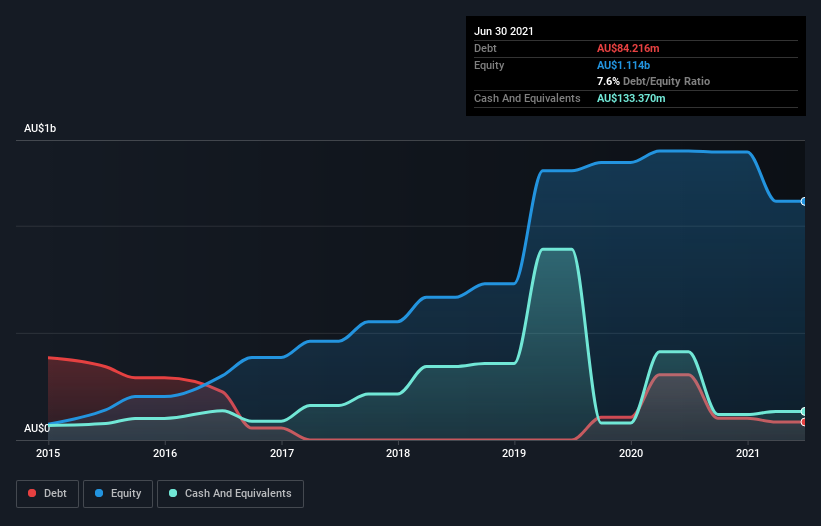Stock Analysis

David Iben put it well when he said, 'Volatility is not a risk we care about. What we care about is avoiding the permanent loss of capital.' It's only natural to consider a company's balance sheet when you examine how risky it is, since debt is often involved when a business collapses. Importantly, St Barbara Limited (ASX:SBM) does carry debt. But the more important question is: how much risk is that debt creating?
When Is Debt A Problem?
Debt is a tool to help businesses grow, but if a business is incapable of paying off its lenders, then it exists at their mercy. Ultimately, if the company can't fulfill its legal obligations to repay debt, shareholders could walk away with nothing. While that is not too common, we often do see indebted companies permanently diluting shareholders because lenders force them to raise capital at a distressed price. Of course, the upside of debt is that it often represents cheap capital, especially when it replaces dilution in a company with the ability to reinvest at high rates of return. The first step when considering a company's debt levels is to consider its cash and debt together.
View our latest analysis for St Barbara
What Is St Barbara's Net Debt?
The image below, which you can click on for greater detail, shows that St Barbara had debt of AU$84.2m at the end of June 2021, a reduction from AU$304.2m over a year. But on the other hand it also has AU$133.4m in cash, leading to a AU$49.2m net cash position.

A Look At St Barbara's Liabilities
We can see from the most recent balance sheet that St Barbara had liabilities of AU$208.5m falling due within a year, and liabilities of AU$313.6m due beyond that. Offsetting these obligations, it had cash of AU$133.4m as well as receivables valued at AU$37.8m due within 12 months. So its liabilities outweigh the sum of its cash and (near-term) receivables by AU$350.9m.
While this might seem like a lot, it is not so bad since St Barbara has a market capitalization of AU$1.10b, and so it could probably strengthen its balance sheet by raising capital if it needed to. But it's clear that we should definitely closely examine whether it can manage its debt without dilution. While it does have liabilities worth noting, St Barbara also has more cash than debt, so we're pretty confident it can manage its debt safely. There's no doubt that we learn most about debt from the balance sheet. But it is future earnings, more than anything, that will determine St Barbara's ability to maintain a healthy balance sheet going forward. So if you want to see what the professionals think, you might find this free report on analyst profit forecasts to be interesting.
Over 12 months, St Barbara made a loss at the EBIT level, and saw its revenue drop to AU$740m, which is a fall of 11%. We would much prefer see growth.
So How Risky Is St Barbara?
While St Barbara lost money on an earnings before interest and tax (EBIT) level, it actually generated positive free cash flow AU$94m. So taking that on face value, and considering the net cash situation, we don't think that the stock is too risky in the near term. Until we see some positive EBIT, we're a bit cautious of the stock, not least because of the rather modest revenue growth. When analysing debt levels, the balance sheet is the obvious place to start. However, not all investment risk resides within the balance sheet - far from it. For example, we've discovered 2 warning signs for St Barbara that you should be aware of before investing here.
At the end of the day, it's often better to focus on companies that are free from net debt. You can access our special list of such companies (all with a track record of profit growth). It's free.
Valuation is complex, but we're helping make it simple.
Find out whether St Barbara is potentially over or undervalued by checking out our comprehensive analysis, which includes fair value estimates, risks and warnings, dividends, insider transactions and financial health.
View the Free AnalysisThis article by Simply Wall St is general in nature. We provide commentary based on historical data and analyst forecasts only using an unbiased methodology and our articles are not intended to be financial advice. It does not constitute a recommendation to buy or sell any stock, and does not take account of your objectives, or your financial situation. We aim to bring you long-term focused analysis driven by fundamental data. Note that our analysis may not factor in the latest price-sensitive company announcements or qualitative material. Simply Wall St has no position in any stocks mentioned.
Have feedback on this article? Concerned about the content? Get in touch with us directly. Alternatively, email editorial-team (at) simplywallst.com.
About ASX:SBM
St Barbara
Engages in the exploration, development, mining, and sale of gold.
Adequate balance sheet with moderate growth potential.

